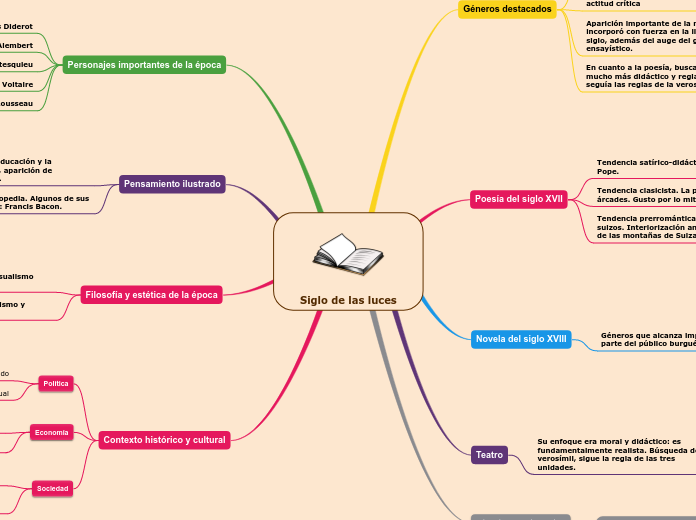Siglo de las luces
Type in the name of the book you have read.
Contexto histórico y cultural
Type the main events of the book, classifying them in: events from the beginning, events from the middle, and events from the end of the book.
Describe the story visually. Add a representative picture for each of them.
Sociedad
La religión empieza a tener conflictos con el teocentrismo.
Aún permanece la sociedad estamental pero hay un avance de la burgesía
Type the main events from the end.
Add a representative picture for each of them.
Economía
Aún había una economía agraria.
Renovación económica debido a avances científicos
Type the main events from the middle.
Add a representative picture for each of them.
Política
Se sentaron las bases de la democracia actual
Despotismo ilustrado
Type the main events from the beginning.
Add a representative picture for each of them.
Filosofía y estética de la época
In contrast to the main idea, the theme is the message, lesson or moral of the book.
Some tips to find out the theme of the book easier:
- Try to find it while you are reading. It may be stated or implied.
- Think about how the characters reacted to obstacles.
- Think about the important decisions that the characters made.
- Think about the characters growing or changing throughout the book.
Postbarroco, Rococó, Neoclasicismo y prerromanticismo.
Racionalismo, empirismo y sensualismo (tendencias filosóficas)
Pensamiento ilustrado
Aparición de la enciclopedia. Algunos de sus principales escritores: Francis Bacon.
Preocupación por la educación y la divulgación del saber, aparición de diferentes disciplinas.
Take notes while you read the book. Write here your favorite quotes from the book.
Personajes importantes de la época
Take notes while you read the book. Type here the resources, books, or websites that the author mentioned and you want to check out later.
Rousseau
Voltaire
Montesquieu
Jean Le Rond D'Alembert
Denis Diderot
Literatura y otas artes
Destacamos a autores como Mozart o Rossini.
Teatro
Su enfoque era moral y didáctico: es fundamentalmente realista. Búsqueda de lo verosímil, sigue la regla de las tres unidades.
The main idea is what the book is mostly about.
Some tips to find out the main idea of a book easier:
- Read the title.
- Look for the text features.
- Figure out if you are reading a fiction or a non fiction book.
- Think about some examples that support this idea.
Teatro eueropeo y español: influencias recíprocas. Hay una gran relación entre el teatro de españa y lo que se gesta en europa. Por ejemplo L'école des mères de Marivaux con el Sí de las niñas.
Comedia sentimanetal y drama burgués: tragedia y comedia tracional, nuevo nombre, comedia sentimental; ligada a una nueva sensibilidad ilustrada.
Pierre Caron de Baeumarchais o Pierre de Marivaux
Novela del siglo XVIII
Type the names of the book characters. Start with the main character.
Draw arrows to represent the relationship between them and if it is possible write on them what they represent for each other (if they are relatives, friends, lovers, enemies etc.)
Géneros que alcanza importancia en gran parte del público burgués
Inicios de la novela inglesa con Defoe: tenía una fuerte influencia cervantina en la novela que empleaba.
Sentimientos y utopía, centrado en los sentimientos y las nuevas circunstancias sociales: a través del género epistolar.
What are the characteristics that best describe the character? Type them here.
Bernandin de Saint-Pierre con Pablo y Virginia
Jean Jacques Rousseau con Julia o la nueva Eloísa
Samuel Richardson con Pamela
Poesía del siglo XVII
What is the reason why the author wrote the book?
Tendencia prerromántica: grupo de poetas suizos. Interiorización anímica del paisaje de las montañas de Suiza.
Tendencia clasicista. La poesía de los árcades. Gusto por lo mitológico.
Tendencia satírico-didáctica, con Alexander Pope.
Géneros destacados
Who is the author of the book? Type in his/her name.
En cuanto a la poesía, buscaba un carácter mucho más didáctico y reglamentario. Se seguía las reglas de la verosimilitud.
Aparición importante de la novela, que se incorporó con fuerza en la literatura de este siglo, además del auge del género ensayístico.
Sátira, epístola y autobiografía: ambas tres defendían la búsqueda intimista destacado del Renacimiento, búsqueda en el interior y actitud crítica
Nacimiento de la prensa periódica: desarrollo de una prensa semanal a través de gacetas o de periódicos relacionados con la opinión pública.

